

CAMPER
ITINERARIES TO DISCOVER
FRIULI VENEZIA GIULIA
•
48 Stunden oder 7 Tage voller Spannung, Kultur und .... Unterhaltung. Eine einzige Karte für Friaul-Julisch Venetien.
FRIULI VENEZIA GIULIA: A PARADISE FOR PET-FRIENDLY HOLIDAYS
Beaches, parks, trails and charming villages offer an unforgettable experience to share with your pet.

Choose from a wide range of places to stay that welcome animals with all the comforts: pet-friendly hotels, agritourism accommodation, B&Bs and campsites.
Organize personalised tours to discover the most picturesque places in the region, take part in animal oriented events and enjoy special moments immersed in nature.

Don’t miss the chance to experience an unforgettable holiday with your furry friend!
Wie groß ist DER VORTEIL?
Ein Wochenende in Friaul-Julisch Venetien zum „vollen Preis“ mit dem Besuch von Sehenswürdigkeiten wie der Basilika von Aquileia, dem Schloss Miramare in Triest, der Grotta Gigante im Karst oder dem Langobardentempel in Cividale del Friuli und mindestens einer geführten Besichtigung würde etwa 43 € kosten.
BUY THE FVGCARD AND ENJOY AN UNFORGETTABLE HOLIDAY WITH YOUR LOYAL FRIEND, DISCOVERING A REGION FULL OF SURPRISES!
48 hours or 7 days of excitement, culture and... fun. A single Card for il Friuli Venezia Giulia.
Mit der 48-Stunden-FVGcard können Sie bis zu 13 € sparen und noch viele weitere hen!
In der Karte ist Folgendes
• Die wichtigsten Museen und Friaul-Julisch Venetien
• Geführte Besichtigungen
• Audioguides
• Der Pass für die Wein- und Genussst Vino e dei Sapori“) von Friaul- enetien, der die Möglichkeit von Weinverkostungen in anges Weingütern bietet

Verkaufsstellen
Infopoint PromoTurismoFVG hlossene Einrichtungen www.turismofvg.it/fvg-card

How CONVENIENT is i for you?
The FVGcard also extends its benefits to 1 child under the age of 12. Free admissions can be used only once for each facility or service. The discounts are only granted to FVGcard holders.
Die Karte ist auch für 1 Kind unter 12 Jahren gültig. Die kostenlosen Serviceleistungen können nur einmal pro Serviceeinrichtung genutzt werden. Die Rabatte werden ausschließlich dem Eigentümer der FVGcard gewährt
A weekend in Friuli Venezia Giulia at “full price” featuring visits to iconic sites such as the Basilica of Aquileia, Miramare Castle in Trieste, the “Grotta Gigante” cave on the Karst or the Lombard Temple in Cividale del Friuli and at least one guided tour would cost approximately € 43 With the 48-hour FVGcard there are savings of up to € 13 with the opportunity to explore so much more!
Included with the FVGcard free of charge
• Access to the main museums and attractions in Friuli Venezia Giulia
• Guided tours
• Audio tours
WHERE the FVGcard is sold
• PromoTurismoFVG Infopoints
•
Entdecken Sie alle Vorteile
• Online at www.turismofvg.it/fvg-card
Discover the services and activities to share with your faithful four-legged friend.
• Hiking tours in the mountains and hills
• The Passport of the Friuli Venezia Giulia Wine & Taste Route, featuring tasting opportunities in the

THE JOURNEY BEGINS HERE
View of the vineyards in Dolegna del Collio
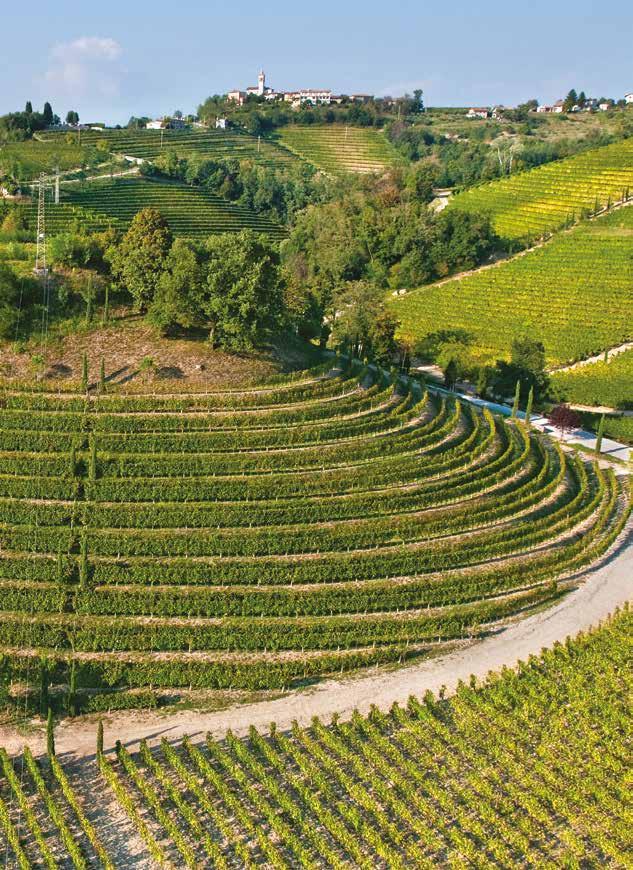
FRIULI VENEZIA GIULIA
BY CAMPER VAN
A guide to discovering unexpected natural settings between the sea and the mountains, along ancient routes and crossroads that know no boundaries. The timeless hospitality of small villages, the thrill of outdoor adventures, and the fascination of art cities.
All year round, let yourself be inspired by events, local attractions, and the desire to share flavours and learn about ancient wisdom. Enjoy a safe, independent holiday—whether you’re with your partner, family, friends, or even pets.
Begin your motorhome adventure here with tips to explore local traditions, culture, and cuisine.
Remember your favourite places and embrace the spirit of Friuli Venezia Giulia.
FROM NORTH TO SOUTH, FROM THE MOUNTAINS TO THE SEA
In Friuli Venezia Giulia, you can experience mountains, hills, and sea all in one trip. Carnia’s mountains offer many outdoor activities and traditional villages with artisan shops, while the plains and hills feature culinary routes. Near the coast, a grand castle and scenic bay invite relaxation in the sun


PART 1
A WALK IN THE MOUNTAINS
Start from Sappada for a tour in Carnia that includes Forni Avoltri, the magical Val Pesarina and goes east until you reach the massif of Mount Zoncolan. Head north towards the border with Austria on the trail of the Great War routes and return following the course of the stream but for a stop in Sutrio and a wellness
break in Arta Terme
Things to do and see Sappada, one of the “Most Beautiful Villages of Italy”, welcomes you at 1,250 metres above sea level with its fourteen hamlets nestled in the Dolomites. For a walk, choose Sappada Vecchia - Plodn, that develops in the upper section of the settlement, surrounded by old wooden houses built with the technique of Blockbau. Several itineraries start from this village. Among the most iconic is the one that brings you to Sesis Valley at the sources of the Piave; walk, bike, or take a shuttle, and stop to sample cheese at a local dairy hut.. You can also choose a hike to the mountain huts where you
can taste the typical dishes of tradition or …the ascent to the lakes of Olbe and Monte Peralba, to be enjoyed as a Nordic walking, mountain bike, e-bike or trekking excursion led by local instructors.
In winter you can enjoy the magic of the snow by exploring the slopes of the Dolomites on snowshoes or snowmobiles and have fun on the alpine ski runs: from the beginners’ areas to the black run of Col dei Mughi, the Pista del 2000 track or the ski slopes of Mount Siera or Pian dei Nidi. A 15-minute drive along an 11-kilometre stretch of road takes you to Forni Avoltri, along the banks of the Degano torrent, at the foot of Mount Coglians, the highest peak in the entire
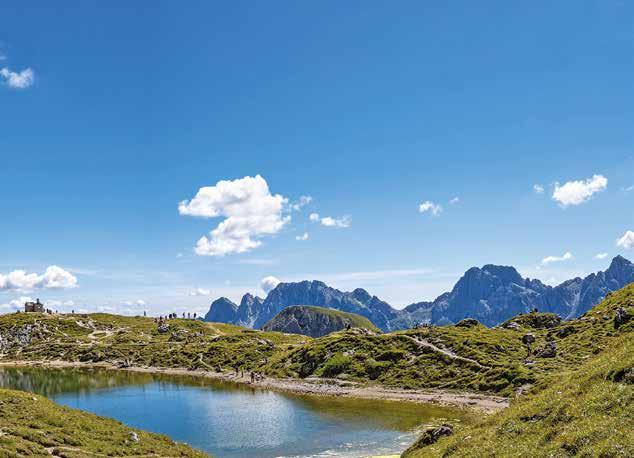
THE ROUTE IN BRIEF
Starting point: Sappada
Arrival: Sistiana Bay
Length: 245 Km
Stages: 16
Ideal for: 10/12 days
Region. The two hamlets that make up the town bear witness to its origins as a mining centre; in fact, the extracted minerals were melted in Forni, while the families of the miners lived in Avoltri. Here you will be immersed in silence and pristine nature; on a trek, you will reach high-altitude mountain huts and First World War trenches. Take a walk to discover the Wildlife Oasis and Lake Bordaglia where stoats, marmots, deer, roe deer and eagles live, or discover the disused ancient mines of Mount Avanza.
Take Regional Road SR355 to Comeglians, then turn right into the Pesarina Valley and drive 22 kilometres (about 30 minutes) to reach Pesariis Protected to the north by the rocky Pesarine Dolomites and to the south by the softer mountains that separate it from the Sauris basin, the valley is known as the “Valley of Time”, an area that has

preserved and handed down the tradition of watchmaking since the 17th century. Take a stroll through the village to discover the clocks on the façades of the houses and visit the master clockmakers to be amazed by their art. Back in your motorhome, head towards Comeglians (18 kilometres, 25 minutes), which preserves historic buildings such as the

Cjase Boter and the Palazzo De Gleria in its hamlets, and on to Ravascletto (6.5 kilometres, 10 minutes), the “Authentic Village of Italy”, ideal for a family stopover near the small lake on the edge of the woods. If you are a cycling fanatic, you can try the “Panoramica delle Vette” route, a 35-kilometre road at high altitude that is not only the most elevated paved road in Friuli Venezia Giulia but also requires great care due to the steep descents that put the integrity of your brakes to the test. In addition to the many routes, both in summer and in winter, you can take the cable car to Mount Zoncolan, 1,740 metres above sea level, with 24 kilometres of slopes for all levels of ability and a bike park with a 360° view of the Carnic Alps and the Friulian Dolomites. Only a short distance to discover the treasures of another small but very precious pearl: Cercivento (6 kilometres, 10 minutes). This mountain village with 16th-century houses featuring characteristic loggias, is home to more than thirty works of art
Marinelli mountain hut, Forni Avoltri
Family trekking, Stavoli di Orias
including paintings, mosaics, frescoes and photo-ceramic reproductions depicting scenes from the Bible. After 2 kilometres you will come to the junction with State Road 52. After turning left and travelling for 9 kilometres (a 10-minute drive), you will arrive at Timau. Here, take the time to visit the small Museum of the Great War and the monument to the Portatrici Carniche, dedicated to the women of Carnia who supplied the men on the Alpine front with food and war supplies.
In the area, be sure not to miss the Fontanòn, a karstic spring of the But and the Timau caves, a system of tunnels that once served the old mines.
Back on the road, the “descent” towards the valley begins with a stop at Sutrio (9 kilometres, 10 minutes), from where the road to Mount Zoncolan begins, a climb that can be travelled by camper van, although it is preferable to take the cable car from Ravascletto.
THE CAMMINO DELLE PIEVI
Mountain, villages, valleys, and 10 historic Pievi, which are small parish churches (concentrated in the stretch between Imponzo and Forni di Sotto) are the strands along which the Cammino delle Pievi evolves, a 260-kilometre itinerary that you can travel on foot, by bike or on horseback.
Divided into 20 stages, it embraces the territories of the upper But Valley, the Pontaiba Valley and the Incarojo Valley with departure from Imponzo
In the village, take a stroll through the historic centre, among the cobbled streets and stone houses that are home to carving and sculpting workshops, true examples of excellent wood craftsmanship. In September, don’t miss the “Magia del legno” (Magic of
di Tolmezzo and arrival in Zuglio.
We recommend tackling it in the good season, between late spring and autumn, which coincides with the opening period of mountain huts, alpine pastures and agritourisms where you can stop for the night. You will be guided by yellow trail markers, signposts featuring the dedicated logo and directional arrows, and the Italian Alpine Club (CAI) markings placed along the way.
Wood) festival, where you can admire and purchase locally made objects and furniture; during the Christmas season, thanks to the “Borghi e Presepi” (Towns and Nativity Scene) event, the village is decorated with festive decorations and many nativity scenes are


displayed in the streets. Arta Terme is only 7 kilometres away and is ready to pamper you, not only with the many possibilities for excursions among the alpine pastures and mountain huts but above all with a modern wellness centre that offers the beneficial effects of the waters of the ancient Pudia spring, which was already well-known for its beneficial properties during the Roman era. Regenerate yourselves!
PART 2
TO THE HILLS AND THE SEA
Tolmezzo and Venzone are the gateway to new experiences between hills and plains, where you can spoil your palate along the route, as in Cormòns, or enjoy a walk overlooking the sea or relax on the beach, as in Sistiana
Things to do and see The valley opens out and meets the Tagliamento river at Tolmezzo, 9 kilometres and a dozen minutes from Arta
Terme; discover its charming historic town centre with the 15th-century church of Santa Caterina and the Casa Janesi, the 18th-century cathedral of San Martino and the valuable “ Michele Gortani” Carnic Museum of Popular Arts and Traditions. Meanwhile, Venzone (18 kilometres, 20 minutes) will welcome you with its medieval walls. In the village, don’t miss the Cathedral of Sant’Andrea, the mysterious Chapel of San Michele and the Gothic-Venetian palace that houses the Town Hall. If you are passing through in autumn and you are a bike lover, drop by the Pasticceria d’Altri Tempi pastry shop to taste the original energy biker bar. A 25-kilometre, 30-minute ride along State Road SS13 and State Road SS356 from Venzone to Nimis is ahead. The area is predominantly hilly and with several panoramic viewpoints, making it the perfect place for an MTB tour. Ready for a taste of local
products? A great tasting session awaits you at the distillery, where to experience grappa such as Ramandolo Classica, Fragolino grape liqueur or cherry brandy, as well as Ramandolo wine. If you love cheese, drive a little further up the road to Taipana and on to the hamlet of Zore (15 kilometres, 25 minutes, last stretch of a narrow road). Here you will find a goat farm with a well-stocked shop selling traditional cheeses such as the Caciotta Caprina, as well as soft and mature goat cheeses. A further 40 kilometres and 50 minutes drive will take you to Cormòns, at the foot of the gentle Collio hills, where you will find another not-to-be-missed speciality: the Prosciutto D’ Osvaldo, which is a limited-production cured meat with a very special flavour that can only be tasted in this area. The wineries invite you to a stopover and the town centre to a walk to the Cathedral of San Adalberto, which overlooks the town, the
Rilke path, Duino Castle
church of Rosa Mistica Santa Caterina and the theatre. Stop at the Cormòns Regional Wine Shop for a wine tasting with a delicious prosciutto and cheese platter. If you have eaten a substantial meal, there is a bike hire point located nearby where you can hop on a saddle and explore the surrounding area. 15 kilometres and 20 minutes separate you from the Redipuglia War Memorial, the massive monument dedicated to the fallen of the Great War, which
preserves the remains of 100,187 soldiers who lost their lives in the surrounding area. 20 kilometres and the same amount of time will take you to the sea and to the Duino Castle, popular in the 18th century and once frequented by famous guests such as Princess Sissi, Johann Strauss and Gabriele D’Annunzio.
Visitors can admire more than 18 rooms, the Palladian staircase, the fortepiano on which Liszt played and an enchanting panorama of the
gulf. If you wish to see more, walk the 1,700 metres of the Rilke Trail, which gives access to the reserve from Sistiana or Duino and winds along a gentle slope, a route suitable for everyone. The final stage is one of total relaxation on the beaches that stretch from the fishing village of Duino to Sistiana (3.5 kilometres away), where there is no shortage of campsites to stop off at.




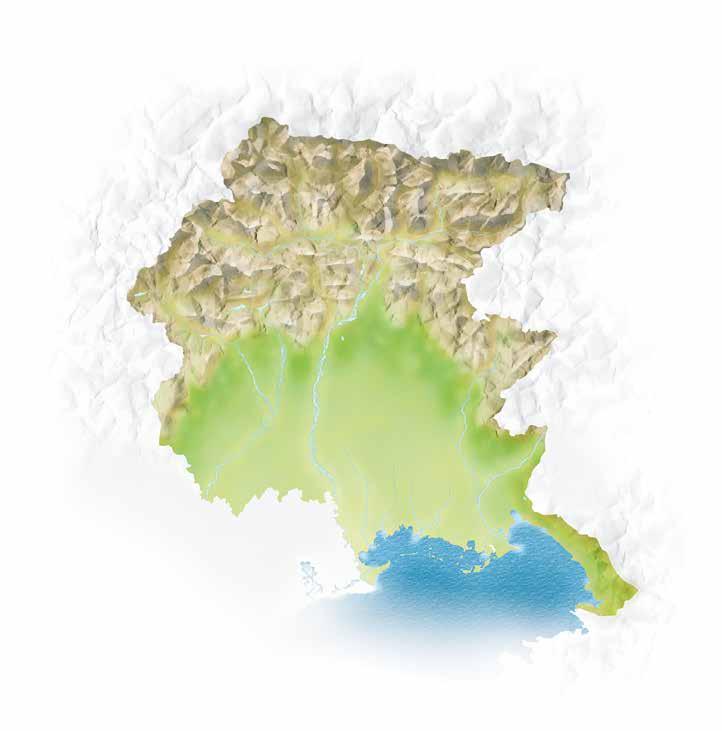
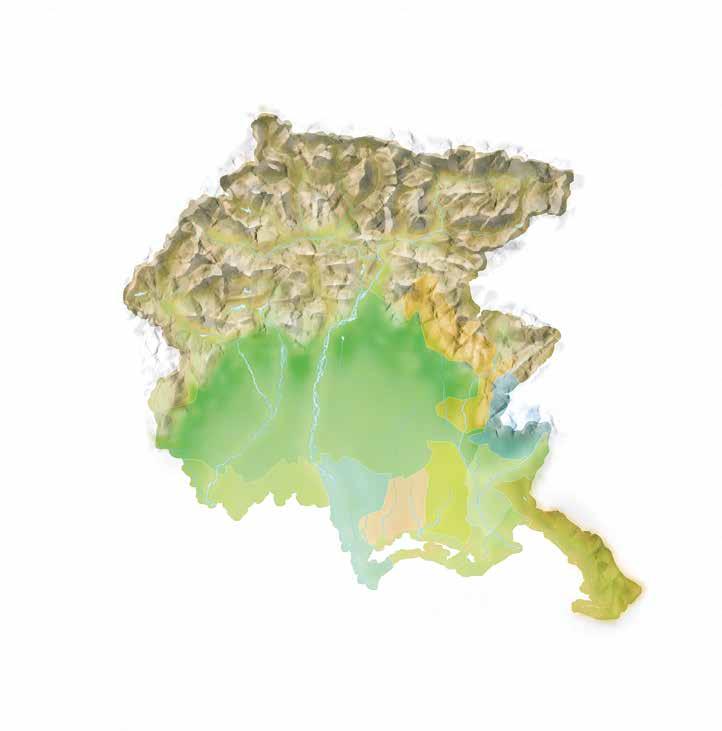
ALL OVER THE MOUNTAINS, FROM CARNIA TO TARVISIANO
Travelling west to east amidst the awe-inspiring mountains of Friuli Venezia Giulia you can follow a route split into two main stages that can be enjoyed both in summer and in winter. You can plunge into the sounds and scents of the woods, refresh yourself in the emerald waters of the streams, walk or cycle, before recharging your batteries in the sunshine of the meadows or in the snow, filled with a magical sense of relaxation that continues at the table with traditional products and exceptional cuisine.

THE ROUTE IN BRIEF
Starting point: Forni di Sopra
Arrival: The Montasio Plateau
Length: 185 kilometres
Stages: 10
Ideal for: 10/12 days
The sunset on Mount Lussari

PART 1
ALL THE BEAUTY OF CARNIA
Plan a few days in Forni di Sopra and its valley to immerse yourself in the magic of the Friulian Dolomites. Then go up to Sauris and enjoy a crystal blue lake, new experiences and flavours that you will find hard to leave...
Things to do and see
Start the route from Forni di Sopra with its ancient houses
made of wood and stone standing in a wide, sunny valley. From the heart of the village to the hamlet of Cella, admire the thirteen ‘”talking walls”, with as many murals on the houses that describe the stories and trades of its inhabitants. Hiking, mountain biking, Nordic walking and mountaineering are just some of the activities for the warmer months, while in winter the snowy slopes for cross-country skiing, downhill skiing and snowboarding await you with a baby snow park and ski school. If you are sporty, try the climbing wall, or if you want to pamper yourself, choose the wellness centre with a Kneipp path and a lagoon with a water playground and slide. If you are travelling with your family, try a donkey ride to discover nature or dive into
Fantasy Park, perfect for keeping the kids entertained both in the summer season (inflatables, elastic nets and donkey rides) and in the winter season with a toboggan and bobsleigh track. The Botanical Gardens and the “Senses of the Dolomites” educational trail will allow you to discover the secrets of the woods in a playful way and with all your senses. With the Varmost chairlift facility, you can reach the Varmost alpine pasture in summer and in winter travel up to an altitude of 2000 metres. The ruins of the Sacuidic Castle stand on a rocky spur overlooking the Tagliamento River and can be reached from Forni di Sopra with a pleasant walk. The meaning of its name, “lookout place” or “place of the devil”, will make the plunge into

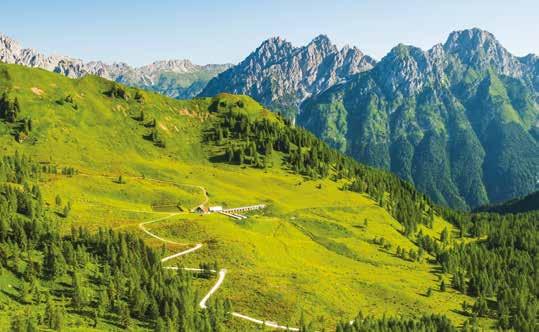
On the tour of the alpine pastures in Sauris
history even more evocative. A fire at the end of the 12th century, aimed at destroying a clandestine activity of counterfeiting coins, destroyed these walls. As you approach Forni di Sotto, which is only 9 kilometres away, you can choose between two magical hiking itineraries to enjoy with your children: the ”Gnome Village” trail, which winds its way through the woods at the bottom of the valley, starting from Sant’Antonio (2 kilometres before Forni di Sotto), and the ”Enchanted Forest” trail, which starts from Borgo Vico. Forni di Sotto, burnt down by the Nazis in 1944, preserves the memories of its past in the three hamlets around which it was rebuilt. The guides at the Friulian Dolomites Park Centre will be happy to suggest itineraries not to be missed; a walk to the edge of the village will take you to the little church
of San Lorenzo, with its precious frescoes and small bell gable. Descend for 13 kilometres (15 minutes) along the convenient State Road SS52 to Ampezzo (a rest area), where you take the Provincial Road SP73, which climbs up to the lake and the village of Sauris at 1,200 metres (14 kilometres, half an hour). Lose yourself in the narrow
streets to discover its wonderful buildings. The oldest and most typical ones, now restored, are made of wood and stone using the Blockbau technique, meaning the use of whole trunks, wedged together at the corners; the balconies decorated with colourful geraniums and the careful geometries of the woodsheds conceal workshops
THE KRAMPUS, MYTHICAL CREATURES
Legend has it that the origins of Krampus date back to pre-Christian times when brave young men disguised themselves in furs, feathers, skins and animal horns to raid and steal from the neighbouring villages. That is until a demon (recognisable by its goat’s paws) infiltrated their ranks and was defeated by the Bishop of Myra.
Since then, between legend and tradition, the Krampus return every year on the eve of Saint Nicholas in long, frightening processions by lantern light, led by the figure of the Bishop. The Krampus are no longer there to steal but to punish the ‘”naughty children”, while instead Saint Nicolas marches by to reward the “good” ones with his gifts.
for carving, woodworking and handloom weaving. There are also small museums such as the Sauris Ethnographic Centre, where you can learn about the culture and traditions of this community. In the hamlets, make sure to visit the Sanctuary of Sant’Osvaldo in Sauris di Sotto and the Church of San Lorenzo in Sauris di Sopra. If you visit during the carnival season, you will discover one of the most fascinating traditions, which brings the typical masks carved in wood to the streets in a colourful procession that moves from Sauris di Sopra to Sauris di Sotto under the light of lanterns. A short distance from the villages and you can enjoy new experiences: trekking and mountain biking following the network of paths, mule tracks and gravel roads that connect villages, shelters and alpine pastures, or horseback riding in nature, even for the youngest, with short rides in the woods next to the stables. You can also enjoy the deep blue waters of Sauris Lake for sport fishing, a canoe or SUP excursion, hiking and MTB itineraries; if you are looking for strong emotions, choose the Sauris Zipline, a 2.5-kilometre long flight at speeds of up to 100 km/h, to be experienced while suspended at more than 1,000 metres above sea level between the forest and the lake, in order to admire the panorama from a truly “special” perspective. In winter, enjoy the two ski areas with slopes bathed in sunshine!
In Sauris di Sopra you can try your hand at medium to difficult slopes, while beginners can take their first ski runs on the school field. In Sauris di Sotto there is a fascinating slope for all levels of ability, which is
illuminated at night. Do you prefer cross-country skiing? The “Plotze” circuit at the foot of the majestic Mount Bivera and the “Untervelt” circuit in Velt are the perfect options just for you. And then ski touring, Nordic walking, snowshoeing and snowmobile tours, even under the stars... And do not leave without tasting and stocking up on flavours. First and foremost, the Prosciutto di Sauris PGI, unique for its sweetness and light smoking obtained with only beech wood, or the alpine pasture cheeses refined and matured at high altitude. You will be surprised by the Zahre Beer, a full-bodied, unpasteurised and unfiltered beer, available in red, hempflavoured and smoked versions, and the smoked trout, bred in the purity of the spring waters and smoked according to the ancient local tradition.
PART 2
THE TARVISIANO
You will arrive in Tarvisio, embraced by an immense forest: an area where, in summer
as in winter, nothing is really missing. Explore the fascinating surroundings: the Fusine lakes, the Predil quarries, the very small Sella Nevea mountain pass and the Montasio plateau
Things to do and see Travelling from west to east first on State Road SS52 and then on the A23 motorway, expect to travel 1 hour and 30 minutes to cover roughly 95 kilometres. Tarvisio is ready to welcome you. The town is close to the borders of Slovenia and Austria, at a lively crossroads of languages, cultures and flavours. Nestled in the forests of the Julian Alps, Tarvisio is embraced by the largest state forest of Italy, covering over 24,000 hectares. The area features many trails for trekking, mountain biking or horseback riding. If you want to reach the top with ease, take advantage of the Mount Lussari cable car that will carry you up to 1,780 metres above sea level where you can visit the Sanctuary, enjoy a 360° view and set off for the alpine pastures and mountain huts.

Yoga - Fusine Lakes, Tarvisio
Would you rather have some fun on your bikes? Try the Bike Park Dell’Angelo with three routes that plunge down towards the bottom of the valley starting from the top station of the chair lift facility. On your bikes, but this time on the road - and only if you are well trained - you can experience a great cycling adventure by retracing a stage of the Giro d’Italia with the 7-kilometre climb and 900-metre elevation gain all the way to Mount Lussari. You can also cycle along a section of the Alpe Adria Cycle Route (400 kilometres from Salzburg to Grado), the Italian section of which starts in Tarvisio, tracing a route partly on disused railway tracks; the bicycle itinerary is well connected to the railway network and will allow you to return to the locations where you left your camper van. If you are travelling with your family, there is the Fun Park at the bottom of the valley. A special playground for children with many attractions, including the
alpine coaster and the exciting zipline.
For the winter, get your skis, snowboards and snowshoes ready to unleash your energy on 24 slopes served by 13 ski lift facilities and 44 kilometres of cross-country trails. For a once-in-a-lifetime adventure, experience the thrill of dog sledging across the snowy white landscape. A chain of mountains protects the basin that is home to the Fusine lakes, which are 11 kilometres from Tarvisio (the parking area is at the end of the road). From here, on foot along the cart track, you can reach the Zacchi mountain hut, an excellent refreshment point, overlooking the entire area. The tranquillity of the greenery and flowers in summer contrasts with the thousands of ice crystals on the lakes in winter, in one of the coldest corners of Italy, to be explored on skis or snowshoes. Back in Tarvisio, stay on State Road SS54 until you reach the Raibl Mines in Cave del Predil
(18 kilometres, 25 minutes). The mine, for centuries one of the most important in Europe for the extraction of lead and zinc, is a network of 120 kilometres of tunnels on 19 levels that descend to a depth of 520 metres; you can explore it on foot or by electric train and complete your experience with a visit to the Raibl Geomineral Park and its museum. After 2 kilometres you will arrive at Lake Predil. Here you can sunbathe on the grassy beaches, go canoeing, have fun on the water bikes or practice windsurfing. You will then have to drive 10 kilometres by caravan to reach Sella Nevea In summer, the gondola lift will take you to an altitude of 1850 metres above sea level. Here there are hiking and mountain bike trails, and spots where you can practice your climbing skills on the crags and also visit the Gilberti mountain hut where you can enjoy a traditional and tasty meal. For the little ones, the Adventure Park offers five

Fontanone di Goriuda, waterfall in the Raccolana valley
acrobatic courses in the trees, while in winter, a cable car and gondola lift take you up to 2,000 metres above sea level for skiing and snowboarding amidst breathtaking scenery.
From Sella Nevea, take a short detour of 7 kilometres into the Julian Prealps Natural Park, to visit the wonderful Fontanone di Goriuda waterfall. Here, icy waters cascade from the top of a large rock cavity creating a waterfall that plunges into a small pool of crystal-clear water. There is a short path around
the pool, taking you through splashes of water right into the cave to admire the waterfall from behind. Return back along Provincial Road SP76 as far as Sella Nevea where you turn left at the hairpin bend signposted “Altopiano del Montasio” (the Montasio Plateau); in addition to the 6 kilometres of descent, you will have to add almost as many uphill stretches, paying attention to the very narrow road with several steep sections. We recommend that you travel uphill at off-peak times to avoid
the risk of getting stuck in traffic with other vehicles. Among the pastures surrounded by an imposing amphitheatre of mountains, do not forget to visit the “malghe” (alpine pastures) loop itinerary, a circuit covering 12 kilometres (and 400 metres of elevation gain) with a stop at the Montasio alpine pasture to delight your tastebuds; if you want to enjoy a good meal and a view of the Mount Canin mountain range, walk to the Di Brazzà mountain hut instead.






OUTDOOR BETWEEN NATURE AND VILLAGES
Discover Friuli Venezia Giulia in an active way through its extraordinary landscapes. Experience the fragrant woodland environment by bike and observe the clear waters of the Tagliamento while kayaking. Take flight in a paraglider or experience the Magredi on horseback. Unwind with a stroll through the villages in search of the unique flavours of this land, then head south. Watch the sunset over the Marano Lagoon and relax on the golden beaches of the coast.


PART 1
CAVAZZO LAKE
AND GEMONA DEL FRIULI
Start your outdoor exploration at the beautiful Cavazzo Lake and continue towards Gemona del Friuli. Trekking, cycling and a paragliding adventure will let you take in all the nature of this area.
Things to do and see Cavazzo Lake is waiting for you in the woods where a campsite on the shores will be your safe haven. To enjoy the scenery from above, climb up the more than 1,000 metres of Mount Festa to reach the First World War fort of the same name, from where you can enjoy a priceless panorama; you will also have the option of cycling or trekking for about 2 hours along a mule track or path. For your bicycle, a route suitable for everyone winds along the western shore of the lake and, if you are fit, you can extend it to a loop itinerary of about 32 kilometres that touches the Tagliamento River
and the village of Venzone
Make the most of the open air by renting a kayak or paddle boat and enjoy the reflections on the water. Only 12 kilometres and a 15-minute drive separate you from Gemona del Friuli. From the town centre, you can reach the peak of Mount Cuarnan, at 1,372 metres above sea level. It dominates the Friulian plain and can be reached in less than 5 hours, but if a short walk and a breathtaking panorama can make you happy, then make sure to climb up to the Cuarnan alpine pasture (the road is not suitable for camper vans because it is narrow and has numerous hairpin
THE ROUTE IN BRIEF
Starting point: Cavazzo Lake
Arrival: Lignano Sabbiadoro
Length: 180 kilometres
Stages: 12
Ideal for: 8/10 days
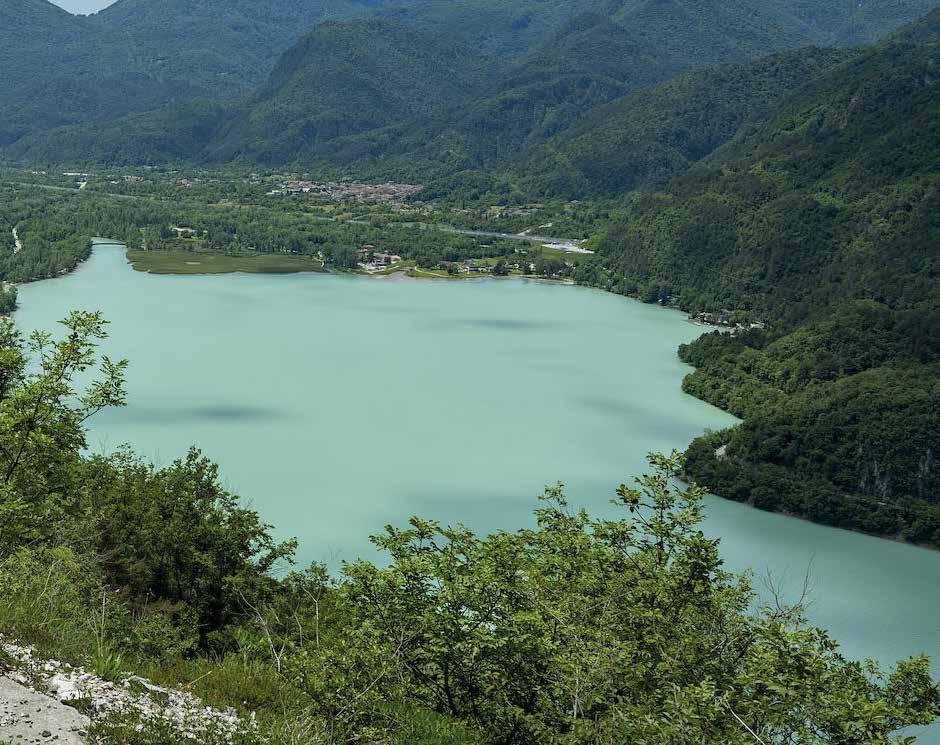
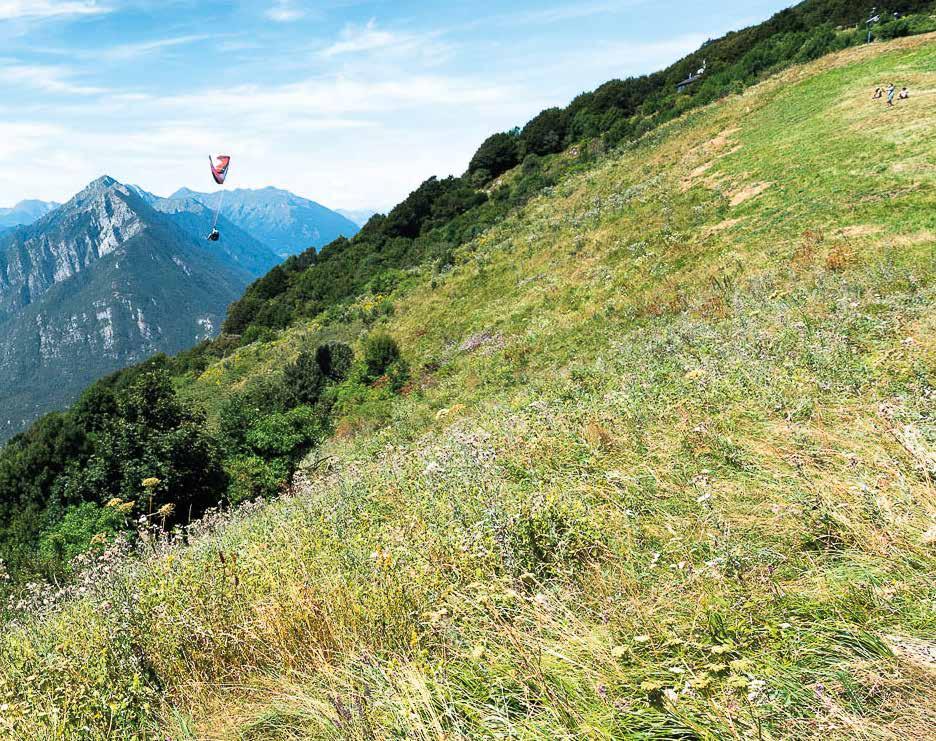

bends) and then continue on foot for about 1 hour. Would you like to experience something truly unique?
Experience paragliding with Volo Libero Friuli, offering scenic tandem tourist flights. In Gemona, relax with a tour of the medieval town centre, looking up at the frescoed buildings of Via Bini and the majestic Romanesque-Gothic architecture of the Duomo of Santa Maria Assunta.
PART 2 FROM THE TAGLIAMENTO RIVER TO THE MAGREDI
Get ready for an outdoor adventure on the crystal-clear waters of the Tagliamento River, visiting two villages with unique flavours and then discovering the territory of the Magredi on horseback.
Things to do and see 22 km and just over 30 minutes heading south will take you
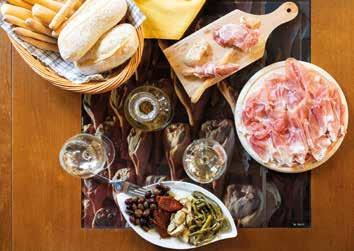
to the sports center in the Pontaiba area where you can meet His Majesty the Tagliamento River
Relax along its banks, or try kayaking and rafting with the Friuli Kayak & Rafting School. Options are available for all skill levels, including children and beginners. If all these activities have tickled your appetite, hop in your camper van and, just 10 kilometres away and just a few minutes on the road, you will be on the hilltop of San Daniele del Friuli, home of one of the finest Italian and international delicacies, Prosciutto di San Daniele PDO. The result of an age-old tradition and a unique microclimate, you can taste and buy Prosciutto from one of the local producers. The next stop, about 30 minutes and 23 kilometres away, is the small village of Toppo, designated as one of the Most Beautiful Villages in Italy. Divided into the two historical settlements of the Masi di Toppo and the hamlet of Pino at the foot of the castle, it is perfect for
Kayak on Tagliamento river
Tasting Prosciutto San Daniele

a walk and a snack to taste the soft salted cheese of Val Cosa. On the way to the area of the Magredi, a must-see is undoubtedly Spilimbergo, recently awarded as one of the Most Beautiful Villages in Italy, located on the banks of the Tagliamento River, which you will reach with a short drive of 14 kilometres along Provincial Road SP22. Take a guided tour or the audio guide and discover its historic town centre, the castle, the Duomo and the Palazzo di Ercole building. Under the Loggia del Comune, as a reminder of the commercial soul of this town, the engraving of the macia is still visible on a pillar, the unit of measure used for the sale of fabrics that comes back to life every year in August during the Historical Reenactment.
Before leaving, don’t miss a visit to the very important Mosaic School of Friuli. A final short 15-minute journey takes you to Vivaro, which is only 13 kilometres away. Here you can enjoy an authentic farm experience in contact with the infinite natural landscape of the Magredi. Explore the area
at a leisurely pace, on foot or by bike, but also on horseback, always with binoculars or a
camera at hand, as wildlife sightings are not uncommon in these parts!
PART 3 BETWEEN THE PLAIN AND THE SEA
Next, turn your camper van south, and enjoy a stop in the villages of the plains between castles and flavours, and let yourself be enveloped by the deep blues of the Marano Lagoon and the sea, the red of the sunsets and the shimmering gold of the beaches.
Things to do and see
The itinerary continues in a southerly direction with a first
THE MAGREDI: THE FRIULIAN STEPPE
10,000 hectares of largely untouched nature, 12 Municipalities and an extraordinary wealth of wildlife. The Magredi, a very special territory of the high Friulian plain between the shores of the Cellina and Meduna torrents, represent an amazing landscape. The dialect origin of the term “magredo” means “meagre land”, describing this arid and stony environment where, particularly in summer, even the grassy expanses appear barren, reminiscent of the great steppes of Eastern Europe.
THE WILDLIFE
Rugged and fascinating, these silent lands are perfect for exploration on foot, but also by bicycle or on horseback. The area boasts
a striking plant life and is surprisingly inhabited by numerous animals, including reptiles and small mammals including hares, wild rabbits, foxes, badgers, and roe deer, as well as predatory birds like kestrels and buzzards.
THE FORMATION OF THE MAGREDI
The Magredi were formed as a result of the relentless work of the Cellina and Meduna torrents that, from the mountains, transported downstream and deposited along their course the deposits that today form this large gravel expanse devoid of water. And yet the area is among the rainiest in Italy and the water is there; it simply runs below the surface due to the very permeable nature of the soil.
Palazzo di Sopra - Spilimbergo
stop after only 11 kilometres amidst the vineyards of San Martino al Tagliamento in the Friuli Grave DOC wine district, for a wine tasting experience immersed among the rows of vines and a visit to the winery. The journey continues with a stop in another charming little village: Valvasone. It can be accessed with a very short drive from San Martino al Tagliamento along Provincial Road SP37, just 3.5 kilometres away. The highlight is Piazza Castello where you will be surrounded by history and the imposing outline of the Castle; not far away, embraced by beautiful porticoed houses, is the Duomo where you can admire a splendid painted organ from the 16th century. The ancient monastery is also worth seeing, while the endless charm of the narrow alleys and historical village streets takes you back in time.
Descend along the Provincial Road SP56 until you cross the State Road SS14 just before the town of Palazzolo dello

Stella. To reach this crossroads, calculate a 30-minute drive and a distance of 33 kilometres. Here you can choose whether to “carry on” towards the sea, reaching Lignano Sabbiadoro or explore the Regional Nature Reserve River Stella where the river ends its course, surrendering to the peaceful waters of the Marano Lagoon. Travelling to both destinations is obviously the best solution! So start with a left turn towards Palazzolo dello
Stella where you can also stop in a quiet picnic area just a stone’s throw from the river (approximately 800 metres from the crossroads). Then turn left onto Provincial Road SP122, leaving the houses behind and crossing the fields to reach the Bilancia di Bepi fishing hut just 9 kilometres or 15 minutes away. This is a historic pile-dwelling construction on the river, equipped with a large fishing net measuring 25 square metres. Visitors here can watch the traditional method of catching fish and also enjoy freshly cooked specialities in the adjacent park, just as they did 40 years ago. Immersed in the Regional Nature Reserve River Stella, all you have to do is dive into nature with a bicycle excursion or a horseback ride along the banks of the lagoon, but above all explore the area by kayak or with a guided boat tour along the Stella River and down to the Marano Lagoon. Enclosed between the strip of land where Lignano Sabbiadoro is
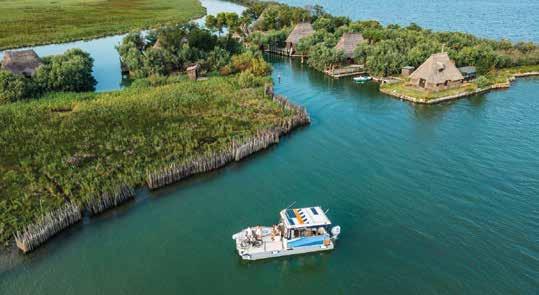
The “Bilancia di Bepi”
Marano Lagoon
located and the Grado Lagoon, protected from the sea by the presence of several small islands, the lagoon is a rich area of plant and animal life. What makes this place even more unique is the presence of the Casoni, the old wooden fishing huts with marsh reed roofs, which are well worth visiting! The sandy beaches of Lignano are definitely within reach by boat, but if you want to reach them with your camper van, you will have to return to the Palazzolo dello Stella
crossroads and …turn left onto Provincial Road SP56 and follow it for 20 kilometres to return to the seaside. In Lignano Sabbiadoro, you will find campsites for your overnight stay and a very long and golden beach. Soak up the sun, take a stroll through the pine forest if you are looking for relaxation, do some shopping in the fashionable shops and enjoy the many nightlife attractions!







Lignano Sabbiadoro
GORIZIA AND SURROUNDINGS
HILLS, RESERVES AND NATURE
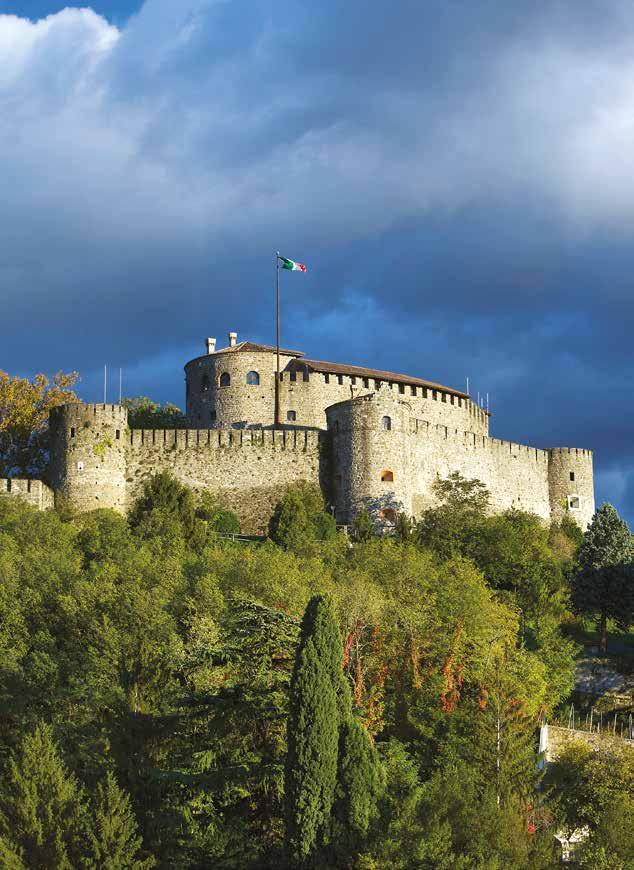
Emotions and flavours come together in this itinerary that starts in Nova Gorica - Gorizia, the European Capital of Culture 2025
Several short itineraries lead travellers from the rose-scented hills to the distinctive flavours of the lowland villages, highlighting the region’s culture and art. Two lesser-known destinations offer opportunities to engage with nature, concluding with panoramic views of the coast and Grado’s beaches, the sunniest in the region.
The Castle of Gorizia
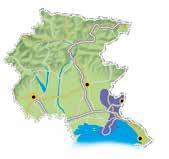
THE ROUTE IN BRIEF
Starting point: Gorizia
Arrival: Grado
Length: 90 kilometres
Stages: 8
Ideal for: 6/7 days
PART 1 BETWEEN VILLAGES AND FLAVOURS
Three villages and an abbey are all ready to welcome you on a fascinating cultural and historical tour primarily set on the plains.
Things to do and see
The castle, the Isonzo River, art and culture, lace, flavours, the Great War, and the border. Start right here, from Gorizia. Part of the Austro-Hungarian Empire for a very long time and then annexed to Italy in 1918, Gorizia is permanently marked by the events that took place on the eastern border of Italy during the Second World War, at the end of which part of the city became part of the territory of Yugoslavia. The division, sanctioned with the construction of the “Gorizia Wall” in Piazza della Transalpina, became one of the symbols of the separation between Western and Eastern Europe. Once the dividing fence was torn down with the entry of Slovenia into the European Union, the
small, pleasant, and peoplefriendly city is now waiting to welcome you. Start in Piazza della Transalpina for a selfie straddling the border and continue to the old town centre, beginning at Piazza della Vittoria with the imposing Baroque church of Sant’Ignazio, notable for its two bell towers and the Neptune Fountain. Proceed to the cathedral and the historic buildings located in Piazza Sant’Antonio and continue along the porticos of Via Rastello to the castle. Positioned on a hilltop, the castle provides expansive panoramic views over the city and its surrounding landscape. On your way to the Abbey of Rosazzo, plan a gourmet stop in Cormòns (13 kilometres, 20 minutes) to “meet” the prosciutto D’Osvaldo, a speciality cured meat, as well as the wines of the territory at the Regional wine shop, the Enoteca di Cormòns. If you take a tour of the village, be sure to visit the Duomo di Sant’Adalberto, the Sanctuary of Rosa Mistica and the theatre; outside the village, walk along the Sentiero
delle Vigne Alte path. The next destination, 12 kilometres away, is the Abbey of Rosazzo in the hills of the Municipality of Manzano, which you will reach in about ten minutes. The location is impressive and offers panoramic views of the vineyards, the villages below, the mountains of Slovenia, the Gulf of Trieste, and Aquileia. The church, dedicated to Saint Peter and built around the year one thousand, is in Romanesque style with three naves and features some preserved frescoes. In spring, allow the fragrance and colours of heritage and contemporary roses to capture you as you walk along the “Rose Trail” around the Abbey. The town Gradisca d’Isonzo is only 20 kilometres away and you will need just as many minutes to reach it; if you have a passion for history, at Borgnano, turn right and add 2 kilometres to your trip in order to arrive in Medea, one of the best-preserved villages of the old Austrian Friuli, where you can admire the eighteenthcentury buildings with their characteristic gates and the impressive Monument to the

Abbey of Rosazzo
Fallen of All Wars, the “Ara Pacis Mundi”, which houses a wooden and bronze urn containing soil collected from 800 national and international war cemeteries.
Only 8 kilometres separate you from Gradisca d’Isonzo, one of the Most Beautiful Villages of Italy, a 15th-century fortress town on the right bank of the Isonzo River. Protected by walls and six mighty towers built by the Venetians in 1479 against Turkish attacks, it has an elegant centre that includes the castle surrounded by other architectural wonders such as the Palazzo del Capitano, the Palladian-inspired Palazzo Torriani, the Cathedral and the 15th-century Church dedicated to Our Lady of Sorrows. To be sure of not missing out on anything, follow two itineraries: “The Palaces between Venice and the Empire” and “The Castle and the Walls”. If you are looking for an experience in contact with nature, the ‘”Parks and Green Areas” route,
which runs through the city parks and along the Isonzo River, is just the thing for you.
PART 2
THE NATURE RESERVES AND THE SEA
Green and blue, the colours that stand out in the second part of your itinerary featuring two astonishing Nature Reserves and a historical seaside village.
Things to do and see
In order to fully enjoy the natural surroundings, it is necessary to drive for 15 kilometres, passing through Doberdò del Lago, the gateway to the Natural Reserve of the Doberdò and Pietrarossa Lakes; the last stretch is unpaved but easy to negotiate. There is a car park in front of the Visitor Centre, a fine example of restoration of an old quarry building, which now houses a small museum and a café. You will then enter into “a world apart”, in stark contrast

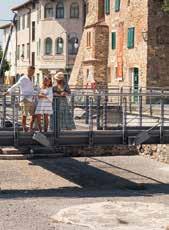
to the barren Karst landscape around you; the reserve is in fact a green oasis where two Karst depressions, separated by a ridge, give rise to as many lakes. Lake Doberdò is one of the few examples in Europe of a karstic basin, and its water level varies greatly until it is reduced to a few metres in depth during periods when the flow of the Vipacco and Isonzo Rivers is weak. A marshy vegetation with riparian forest grows along the banks, a refuge for many birds and other animals such as roe deer, foxes and the much more elusive golden jackal. The Reserve also protects the archaeological site of a Bronze Age fortified settlement known as “Castelliere”, possibly one of the earliest forms of human habitation in the Karst. The area is open to the public and the Visitor Centre can provide you with information, maps and recommendations on the various trails. Just 15 kilometres and 25 minutes of flat road will take you to the Regional Nature Reserve of the Isonzo Mouth and the
Camargue horses, Isola della Cona
In the heart of Grado
Island of Cona in a completely different landscape. Go to the visitor centre in the middle of the Cona Island Reserve, get a ticket and a pair of binoculars and start exploring. You can walk a 2-kilometre loop through freshwater marshes, saltwater wetlands, reed beds, forests and meadows where Camargue horses graze freely, or a 5-kilometre trail that takes you to the mouth of the Isonzo River. Along the itineraries, you will find birdwatching huts, a refreshment stand
and an equestrian centre. For a guided tour or a canoe excursion, please contact the guides of the Reserve. Then there is Grado, where the beach has received a record number of Blue Flag awards. lying on a strip of land between the lagoon and the sea, only 25 kilometres and 30 minutes away. Stroll through the narrow streets and small squares overlooked by the fishermen’s houses and, in the old town, all the way to Campo dei Patriarchi, to see
the Basilica of Sant’Eufemia and the Basilica of Santa Maria delle Grazie. You could pick your spot in the sun (which is always shining here) on the 3 kilometre-long South-facing beach or, alternatively, go sailing among the islands of the lagoon, mooring at the island of Barbana, boasting one of the oldest Marian shrines in the world, or at Mota Safon island, where the Casone Pasolini is located.






PORDENONE AND SURROUNDINGS
THE ART OF ELEGANCE

The same charm and two very different worlds merge into a single itinerary rising from the plains to reach the Piancavallo mountain resort and the majestic peaks of the Friulian Dolomites Natural Park. The hushed sounds and atmospheres of the countryside envelop the small and beautiful villages and then give way to the scents of the woodlands and the silence of the peaks. Halfway between them there’s the prospect of a fun stopover by the dazzling green waters of a lake and, as always, good food is a guarantee.
Corso Vittorio Emanuele, Pordenone
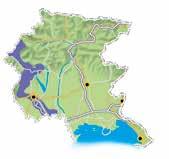
THE ROUTE IN BRIEF
Starting point: Cordovado
Arrival: Erto
Length: 180 kilometres
Stages: 13
Ideal for: 8/10 days
PART 1
THE VILLAGES OF THE PLAINS Towers, churches and narrow streets are the main attractions of these little gems, which preserve their history along with magnificent buildings. The last stop is a detour to the area surrounding Piancavallo, where you can get your first taste of the mountains.
Things to do and see Located in the plains of Pordenone, Cordovado is the starting point of this itinerary and, not surprisingly, it is included in the circuit of the Most Beautiful Villages in Italy. A walk around the medieval village will allow you to admire the traces of its ancient origins, the castle with its two entrance towers, the ancient parish church of Sant’Andrea and the 17th-century Sanctuary dedicated to the Virgin Mary. 7 kilometres to the west, almost on the border with the Region of Veneto, you will find Sesto al Reghena, which is also one of the Most Beautiful Villages in Italy. Built around the ancient Benedictine Abbey of Santa
Maria in Silvis, the village retains to this day the peace and tranquillity of the countryside in which it nestles. After passing under the Grimani Tower, the only one left out of the seven that once defended the Abbey, you will be at the foot of the bell tower, next to which is the Abbey’s Chancery. Visit the church, which features three cycles of incredible frescoes, and then the historic building known as Palazzo Burovich, with its partially frescoed façade and beautiful Italianstyle garden. Next, turn your camper van north towards the A28 motorway, and in about 25 minutes you will cover the 24 kilometres that separate you from Pordenone, the painted city and Italian Capital of Culture 2027. In the heart of the town, walk around under the arcades of Corso Vittorio Emanuele II, which cuts through the historical centre, admiring the frescoed palaces and shops; stop for a coffee in front of the ancient 13th-century Loggia that is home to the Town Hall and visit the Duomo di San Marco with the masterpieces of the painter Giovanni Antonio
de Sacchis, also known as ‘il Pordenone’. Then stop by the Civic Art Museum in the halls of the Palazzo Ricchieri building, which was once an elegant aristocratic residence. After leaving the old town, you’ll reach the Adam and Eve bridge, whose statues actually depict Jupiter and Juno. It crosses the Noncello River, the starting point of many itineraries.
Take State Road SS13, a transfer of 12 kilometres and 20 minutes that will take you to Sacile, the garden of the Venetian Republic! Follow your instincts as you explore the narrow streets and bridges of this town, where the Livenza River mirrors parks and elegant buildings, adding to the stunning views. The 16th-century palaces make it a “Renaissance city” and you will discover this with your own eyes by visiting the Loggia Comunale and the Palazzo Ragazzoni. Also worth seeing are Piazza del Popolo, overlooked by buildings with porticoes, the Duomo and the little church of the Madonna della Pietà. During the appropriate season, it is possible to visit Caneva to try

A stroll through the village of Sesto al Reghena
FigoMoro, a type of fig known for its sweet taste. A distance of 12 kilometres, approximately ten minutes by car, separates you from the Palù di Livenza pile-dwelling area, which was designated as a UNESCO World Heritage Site in 2011. This site is located in a wetland and marshland at the sources of the Livenza River. Here, in the Neolithic period, a pile-dwelling settlement developed, of which several archaeological finds have been discovered in perfect condition, such as broken stone tools, ceramic fragments and the wooden remains of huts. In the area, there are pleasant archaeological and nature trails to visit the most interesting sites, while some of the archaeological finds are exhibited in the Archaeological Museum of Western Friuli in Pordenone. Within a few kilometres, the hilltop castle overlooking Polcenigo designated as one of Italy’s Most Beautiful Villages — will come into view. A camper van rest area is conveniently located nearby. The hill is home to the
parish church dedicated to San Floriano and the castle, which was destroyed by fire and rebuilt in the mid-17th century as a Venetian villa. On the downhill stretch, you will come across the church of San Giacomo previously associated to a Franciscan convent. In the square, Palazzo Fullini and other neighbouring buildings add to the appeal of Polcenigo. Stay on Provincial Road SP29 and after 7 kilometres you can branch off to Piancavallo, a terrace overlooking the plain. In summer, a dense network of trails through woods and pastures will allow you to find the right itinerary for your training. The Tremol chairlift will take you up to 1630 metres, where you can stop at the Arneri mountain hut for a panoramic lunch of local specialities before starting your high-altitude trekking; fun is also guaranteed if you are travelling with children, who will find an area at the bottom of the valley entirely dedicated to their fun and enjoyment. 14 kilometres of slopes and ski

facilities featuring a large snow park, bordercross track and skicross for snowboarders and skiers are ready to welcome you during the winter season. If you love cross-country skiing, 15 kilometres of tracks and a floodlit ring will be your paradise. If, on the other hand, you want to enjoy the silence, choose a peaceful snowshoe experience. Does speed excite you? Then get ready for a breathtaking downhill ride with alpine coaster!
PART 2
TOWARDS THE DOLOMITES
On the shores of Lake Barcis and the uphill climb among the harsh and enchanting rocky cliffs of the Friulian Dolomites.
Things to do and see
From Aviano, take Provincial Road SP29 to Maniago (17 km, 20 min) and visit the Museum of Blacksmith’s Art and Cutlery, renowned worldwide for its craftsmanship. If you still have room in your food storage hamper, drive all the way to Cavasso to stock up on the Red Onion of Cavasso Nuovo, a vegetable with strong bonds to the territory, which is aromatic and particularly sweet. A detour of 9 kilometres from Maniago will take you to Poffabro, one of the Most Beautiful Villages in Italy, an open-air museum in the Colvera Valley. Take the time to observe and admire the simplicity and wisdom of the rough-cut stones used to build the houses, the staircases, balconies, arches and columns, decorated with beautiful wooden balconies. From Maniago, take Regional Road SR251 to Lake Barcis with its turquoise waters and sunny
Barcis Lake, at the foot of the Friulian Dolomites UNESCO site
valley: here you can sail, surf, canoe, kayak, hike, cycle, or relax at equipped picnic areas along the shore (a rest area for camper vans is available). Follow the lake along Regional Road SR352 surrounded by the mountains as far as Cimolais (17 kilometres, 20 minutes, a rest area). Of the many possible destinations, a must-see in the Friulian Dolomites Natural Park is the Campanile di Val Montanaia peak in the upper Cimoliana Valley. You can start the itinerary from the
Rifugio Pordenone mountain hut; the road from Cimolais is already worth the trip, but it is nevertheless a narrow mountain track that is 10 kilometres in length, partly asphalted and partly unpaved (5 kilometres are subject to a toll). This road is best travelled with vehicles that are not oversized and with some prior experience of driving in the mountains. You can find all the directions on the website of the Rifugio Pordenone mountain hut. Then climb on foot to the
hut and up to the base of the wonderful rock tower where you will be surrounded by an imposing crown of peaks. Back in Cimolais, continue for 11 kilometres until you reach Erto and the parking area in front of the Vajont Dam. The guided tour will take you along the walkway of the dam from which you can observe the impressive setting of the Monte Toc landslide, which on October 9 1963 caused the destruction of a dozen villages at the foot of the dam.






UDINE AND SURROUNDINGS
A TOUR OF THE UNESCO WORLD HERITAGE SITES

An itinerary through the villages. Here you will find the settlements that have been declared World Heritage Sites by UNESCO and also those that have been included in the circuit of the Most Beautiful Villages in Italy. Places where you can be embraced by the buildings and arcades, but also by traditions such as the tajut in the taverns of Udine, and by typical delicacies such as the Gubana in Cividale del Friuli. Prepare yourself for a slow journey among bridges, castles, alleys and palaces, where you can discover the scents and flavours of truly unique dishes.
The Devil’s Bridge in Cividale del Friuli

THE ROUTE IN BRIEF
Starting point: Cividale del Friuli
Arrival: Aquileia
Length: 110 kilometres
Stages: 7
Ideal for: 4/6 days
PART 1
CIVIDALE DEL FRIULI AND CODROIPO
History and elegance come together in these first stages marked by different peculiarities but linked by the same authenticity.
Things to do and see Cividale del Friuli, the capital of the first Lombard duchy, is the starting point of this itinerary that takes you to discover three UNESCO World Heritage sites. The town is in fact part of the “Lombards in Italy: Places of Power (568-774 A.D.)” project that features important testimonies of the Lombard history in Cividale. Visitors can admire the Christian Museum and Treasure of the Cathedral as well as the National Archaeological Museum. Just a few steps away, still in the heart of the town, is the Oratory of Santa Maria in Valle, better known as the Tempietto Longobardo. The simplicity of its exterior does not reveal the splendour preserved inside. Built in the
8th century by the Lombards, and enriched in later periods, it is a jewel not to be missed. Take time to admire the Duomo and stop for a photograph on the Devil’s Bridge over the Natisone River; nearby, visit the fascinating Celtic Hypogeum, which descends into a system of underground caverns whose function remains a mystery to this day. After travelling 16 kilometres on State Road SS54, you will arrive in Udine in approximately 15 minutes. This is a sophisticated city in the heart of a winegrowing area that produces 80 million bottles each year and boasts 10 DOC and 4 DOCG wine districts. And yet, if you have a deep passion for culture, you are definitely in the right place! You will find exhibitions, theatres, the Civic Museums, many bookshops, as well as a wide range of taverns where you can enjoy typical specialities accompanied by a good glass of wine. Begin at the hill featuring the castle and proceed toward Piazza della Libertà, where the Clock Tower (built, of course, by the master clockmakers of Pesariis) overlooks the Loggia di San Giovanni; stroll among the historic buildings surrounding Via Mercatovecchio and stop for a coffee or an aperitif in Piazza San Giacomo, the outdoor “living room of Udine”.
15 kilometres northwest, the ruins of the castle and the small church of San Michele dominate the ancient hamlets that since 1216 have given life to Fagagna, one of the fifteen Most Beautiful Italian Villages in the Region. The cobbled narrow streets will lead you to discover palaces and churches (where you can admire five historic organs), the parish church of Santa Maria Assunta and the Museum of Peasant Life, located in a typical 17th-century country residence. The castle of Villalta is more secluded. It towers over the countryside, protected by crenellated walls. From here, proceed to Codroipo, 25 kilometres away a 30 minute journey.
The town is located in the centre of the resurgence area with a very green park that you can walk or cycle through while passing irrigation channels and mills. Its architectural and artistic highlight is the splendid Villa Manin, residence of the last Doge of Venice surrounded by a park with trees from all over the world. During your visit, you will be surprised by the room with the original bedroom furniture that once belonged to Napoleon.
PART 2
SOUTH OF UDINE
The intriguing geometries of Palmanova, the stone houses

The architectural complex of Villa Manin in Passariano
of Clauiano, the castles of Strassoldo and all the history of the great city of Aquileia are all waiting for you.
Things to do and see Leaving Codroipo, drive along the Regional Road SR252 for 30 minutes and as many kilometres to reach the extraordinary geometric shapes of Palmanova, the fortress city. The nine-pointed star-shaped layout of its geometry, designed by the Republic of Venice on the model of the “Ideal City”, is a rare example of military architecture in the modern age. Because of its uniqueness and the exceptional conditions in which it has been preserved, it was declared a UNESCO World Heritage Site in 2017, and a year later it was included in the list of the Most Beautiful Villages in Italy. Entering through one of the three gates, with a single glance, you will have a view of Piazza Grande, a perfect hexagon in the centre of the town; from here, and again with a single glance, it was possible to control access to the fortification. The square is surrounded by impressive buildings and architecture: the Duomo Dogale with its Baroque façade, the Palazzo del

Provveditore Generale, symbol of the civil power, the Loggia della Gran Guardia, the Loggia dei Mercanti and the Palazzo del Monte di Pietà. Along the perimeter, you will encounter the defensive lines with bastions and ravelins, while a guided tour will take you into the system of underground tunnels that were built for the movement of troops and defence purposes.
A short detour of just 4 kilometres will take you to Clauiano, a charming village made of stone and rock, which has also been included in the list of the Most Beautiful Villages in Italy. The poetry of this small medieval village lies

in the simplicity of its origins, reflected in the architecture of its stone façades and portals. Stroll among the houses clustered around the churches of San Giorgio and San Martino, now forming a single nucleus, to find historic courtyards and views, including Casa Gardellini, considered the village’s oldest home.
Heading south from Palmanova, it takes 15 minutes to drive the 10 kilometres to Strassoldo, a village with two castles founded and still owned by the Counts of Strassoldo-Graffemberg. This village has also been designated as one of the Most Beautiful Villages in Italy and is best discovered on foot, starting from Castello di Sopra, the castle where the historic Porta Cistigna gate - the main access point across the city walls – is located. Walk along the cobblestones until you reach the small square with the church of San Nicolò and the Ottonian tower. Cross a small bridge and you will be at the Castello di Sotto castle, beyond which lies a large park adorned with fountains, wells, statues and ponds. After a visit to the small church of San
Walking through the history, Strassoldo
An aerial view of the extraordinary architecture of Palmanova
Marco, take the time to discover the Borgo Nuovo and the mill of Bosco. A 15-minute drive on Regional Road SR352 will take you to your next stop, located 12 kilometres away. Today, it is hard to picture the tranquil town of Aquileia as once being among the Roman Empire’s greatest cities – yet this was a bustling hub of trade and a vital link between East and West. Designated a UNESCO World Heritage Site in 1998, it preserves a remarkable legacy and heritage.
In the Basilica of Santa Maria Assunta, visitors can admire the frescoes and the splendour of the mosaics that decorate its floor. Adjacent to the building, the Südhalle (south hall) awaits you, with another mosaic floor composed of three fields, while in the new ‘”Domus and Episcopal Palace” a path winds its way through structures and pavements (with layers that stretch down to 4 metres below ground level) in which you will lose yourself in an exciting journey through time from the
1st to the 5th century. Continue with a tour of the Roman Forum, which was the heart of the life of the city, as well as the ancient river port. That’s right, because a very wide river flowed here, allowing ships of great tonnage to navigate its course all the way to the sea, which at that time was 10 kilometres away. Complete your sightseeing trip with a visit to the Early Christian Museum, followed by an exploration of the Decumanus of Aratria Galla, which links the river port to the Forum.






TRIESTE AND SURROUNDINGS
THE CASTLES AND THE KARST

Embark on a journey where history, nature, the sea and the mountains collide, all within easy reach from Trieste. You can wander through a clifftop castle with dreamy sea views, witness an ancient natural wonder, and explore a valley with pre-Alpine features that feels oddly out of place so close to the sea. And finally, Muggia, a hidden gem that with its Istrian-Venetian charm creates a storybook setting.
Miramare Castle

THE ROUTE IN BRIEF
Starting point: Miramare
Castle
Arrival: Muggia
Length: 50 kilometres
Stages: 5
Ideal for: 3/5 days
THE ITINERARY ALL AROUND TRIESTE
A fairytale castle, a colossal underground cave, and the stunning city of Trieste – just the beginning. Venture further to discover an unusual valley and a colourful peninsula.
Things to do and see The sea is your constant companion on this journey beginning with a tour of the dazzling Miramare Castle. Perched majestically above the Gulf of Trieste, its gleaming white Istrian stone walls cutting a striking silhouette against the deep blues of the Adriatic, this architectural wonder welcomes visitors with sun-dappled buildings and exceptional sea views, whilst the surrounding park envelops you in a symphony of colours and fragrances.
Commissioned by Archduke Maximilian of Habsburg, it served as his residence together with his wife, Charlotte of Belgium, starting from the year 1860. Dominated
by its Clock Tower, the building was home to Maximilian and Charlotte’s private living quarters on the ground floor, and it also provided state rooms for guests on the first floor; to this day, the authentic furnishings of the more than 20 rooms of the Castle are still preserved and visible to visitors. An area of 22 hectares and many years of effort by Maximilian of Habsburg himself transformed an almost barren land into the park we see today, with many botanical species introduced from abroad, often as a result of the Archduke’s travels around the world. You can admire a “woodland” area where large trees, grassy lawns, footpaths and ponds are predominant, while another part of the park is characterised by geometry, such as the Italian-style garden in front of the “Kaffeehaus” and the flowerbeds surrounding the small harbour. Please make sure not to miss the greenhouses, the Castelletto building, the stables and the ducal bath complex.
Perched majestically above the Gulf of Trieste, its gleaming white Istrian stone walls cutting a striking silhouette against the deep blues of the Adriatic, this architectural wonder welcomes visitors with sun-dappled buildings and exceptional sea views, whilst the surrounding park envelops you in a symphony of colours and fragrances.
For a true taste of local flavour, seek out the Osmize - quaint, rustic farm-taverns dotting the Trieste hillsides, offering local wines and regional specialities to enjoy on site or for sale.
Just 14 km (30 minutes by camper) from these delights, nature unveils one of its most awe-inspiring creations: the colossal Grotta Gigante, a cave that began forming approximately 10 million years ago. The 850-metre journey through time features 500 steps that take you 100 metres below the earth, into a cathedral-like cavern spanning 365,000 cubic metres lined with towering stalactites and stalagmites.


A mere 25-minute drive (13km) returns you to Trieste, the cultured regional capital where Habsburg past grandeur meets a mosaic of languages, religions and ethnicities. Surrounded by splendid buildings on three sides and facing the sea on the other, Piazza Unità d’Italia is in every sense the gateway where merchants, seafarers, scholars and royalty all came to shore. The square is certainly the right place for a coffee or an aperitif at sunset and the perfect starting point for a walk. This is where you can
admire a crown of palaces, including the ancient Palazzo Pitteri, Palazzo Stratti with its famous Caffè degli Specchi and the Town Hall. In the centre stands the Fontana dei Quattro Continenti (Fountain of the Four Continents), while the Molo Audace pier extends into the sea on the opposite side of the square.
After marvelling at the grandeur of the Verdi Theatre, stroll just steps away to the elegant Canal Grande – the centrepiece of Empress Maria Theresa’s 18th-century Borgo Teresiano district. Here, the
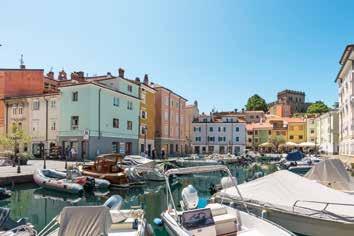
water mirrors a perfect tableau of merchant palaces, historic cafés, and bobbing colourful boats. While three bridges once spanned these waters, today only the iconic Ponte Rosso remains as the perfect vantage point. Pose beside James Joyce’s bronze statue, the famous Irish author who once lived here, with the majestic dome of Sant’Antonio Nuovo completing the picture. On the way up the hill, you can visit the Cathedral of San Giusto, which contains frescoes of the Venetian school and a beautiful mosaic, while behind it is the Castle of San Giusto; on your way back to the waterfront, the Roman amphitheatre is also worth a visit. If you plan your autumn escape to Trieste around the second Sunday in October, you will feel the electric energy that engulfs the city during the Barcolana, the world’s largest sailing regatta.
A 15-minute drive (11 km) will take you to the Rosandra Valley Nature Reserve’s Visitor Centre.
Just beyond the city, stretching toward the Slovenian border, lies this hidden valley of untouched beauty. Crossed by the Rosandra torrent, it is an oasis of peace and nature where you can walk or cycle to discover its waterfall, caves and the remains of the Roman aqueduct. In its woods, it will not be difficult for you to spot one of the 130 species of birds that “populate’” the area. Among the many accessible itineraries, there is a beautiful route that starts from the village of Bagnoli della Rosandra and leads to the remains of a Roman
The view from the Rosandra Valley
The small harbour of Muggia
aqueduct, an old mill and the Church of Santa Maria in Siaris, overlooking the 40-metrehigh waterfall. For the return journey, you can follow the picturesque route of the old Trieste-Erpelle-Cosina railway, which was built between 1885 and 1887 and has now been converted into a cycle track. The village of Muggia is only 10 kilometres away, which you can reach in about fifteen minutes. When you arrive at the bay of Muggia, push on to the small harbour of the
village and stroll through the narrow streets; then stop in the beautiful Piazza Marconi square to discover the Duomo and to enjoy a break and a taste of good food and drink. If the settlement traces its roots back to approximately the year one thousand, the promontory has a much older history, as evidenced in the Archaeological Park by the remains of the ancient fortified settlements known as the Castellieri of Santa Barbara and Muggia Vecchia. Nearby,
the Basilica bears witness to its Roman and medieval past. After soaking in the spectacular views of the Gulf of Trieste, the Adriatic invites you back to its shores. Unwind on the smooth pebble beaches or hop on a shuttle boat with your bikes and set sail for hidden coves along Trieste’s coastline or aim for the sandy shores of Grado and Lignano Sabbiadoro.






AMONG WONDERFUL NATIVITY SCENES

The Nativity in Poffabro
Each village preserves its own traditions and there are many nativity scenes to visit if you are travelling by camper van during the Christmas season; the following are the most important ones, unique for their characteristics and, for this very reason, simply not to be missed.
THE MUST-SEE NATIVITY SCENES
Who says Nativity scenes belong only in snowy villages?
In Lignano Sabbiadoro, the beach itself becomes a Christmas canvas! Visit the magical Sand Nativity, entirely sculpted from sand and water. Each winter artists transform the golden shore into themed biblical tableaux. Skilled hands create and maintain the installation using just water. From mid-November to early February, Spilimbergo transforms its Piazza Duomo into a luminous wonderland with the world’s most dazzling mosaic Nativity. Marvel at
over 40 life-sized figures, each adorned on both sides with thousands of hand-cut tiles, glistening gold leaf and vibrant enamel glass. This breathtaking spectacle celebrates the town’s legendary mosaic heritage, home to the internationally renowned Friuli Mosaic School.
In Sutrio, Christmas tradition is expressed through handcarved wood. The magnificent Teno Nativity stands as Gaudenzio Straulino’s life’s work – thirty years of patient chiselling transformed into a multitude of wooden figures. But the wonder doesn’t stop there: wander snow-dusted hamlets where local artisans
hide miniature Nativity scenes in unexpected nooks, courtyards and loggias.
In Grado, the Christmas story floats on lagoon waters. Behold the enchanting Floating Nativity, a miniature island in the harbour, where the Holy Family finds shelter in an authentic fisherman’s hut with a thatched roof. But there’s much more: the entire historic centre transforms into the ‘Island of Christmas’ with over 100 Nativity scenes tucked into alleyways and hidden nooks.
In Cividale del Friuli visit the Monastery of Santa Maria in Valle where every year the historic Ursuline Nativity
scene is displayed, where the little statues are patiently crafted using wax for the heads and hands and oakum for the bodies. According to an ancient tradition, the figures are dressed with great attention to detail, typical of the inhabitants of Cividale between the 17th and 19th centuries. In Polcenigo, the magic of Christmas is enhanced by the floating nativity scene set up at the Gorgazzo spring and with other illuminated works on display in the streets of the hamlets. You will also find many handcrafted nativity scenes in the narrow streets of Poffabro, with courtyards, balconies and windows creating an enchanted atmosphere.The evocative medieval tower and the “Via dei Presepi” (the Street of Nativity Scenes) are the backdrop for the exhibition held in Moggio Udinese, where every year dozens of representations, made using a variety of techniques, take part in a competition to award the most interesting entry.


The Nativity in Sutrio
TRAVELLING FROM ONE EVENT TO THE NEXT

A weekend or a trip with your camper van can become a treasure hunt where every stop promises beautiful locations, local traditions and the delicious flavours of traditional cuisine. Time your trip with local celebrations and embrace the authentic spirit of this region.
BETWEEN FESTIVALS AND EVENTS
Scattered across the Region according to the passing of the seasons, there are numerous events you can plan for a camper van tour. The Barcolana, the most popular regatta in the world, has been staged in the Gulf of Trieste in mid-October for over 50 years. It attracts enthusiasts and tourists not only to enjoy an unforgettable experience on the water but also to take part in the events and stands that animate the city.
If you have a passion for authentic traditions, don’t
miss the Carnival of Sauris in February, a procession of traditional masks, hand-carved in wood, which parade at night, illuminated by lanterns, from the village of Sauris di Sopra to Sauris di Sotto. The Mittelfest, on the other hand, is an eclectic festival of theatre, dance and music from Central Europe where for 10 days in Cividale del Friuli exhibitions and artists perform in shows, dance, music, theatre and circus acrobatics.
If you love reading, Pordenone transforms every autumn to host “Pordenonelegge”, Italy’s most vibrant literary festival,
featuring 300+ events, 600 authors and much more, all of which can be enjoyed for flavour-hunting travel opportunities? September could be the right month for you! In Gorizia, the Gusti di Frontiera festival is a 4-day food and wine event that allows you to discover the flavours and traditions of more than 50 countries around the world with hundreds of stands, show cooking sessions, workshops, music and tasting experiences. Another tasty opportunity is Friuli DOC, a major festival to discover the excellent wines and food of the
Medieval in Valvasone
Region. You can enjoy them in the squares of Udine and its taverns, which are ready to welcome you to discover the genuine soul of this land. In addition to the wines of Friuli Venezia Giulia, you will also have the opportunity to taste local Prosciutto, cheeses and desserts. There will also be plenty of tasting sessions and workshops.
The village festivals also showcase many typical products, where you can combine tasting and shopping with a sightseeing tour of picturesque hamlets. Three events that are not to be missed are the Sagra del Frico in Carpacco, which celebrates the typical Friulian dish of cheese, potatoes and onions; the Festa del Prosciutto in Sauris, where you can taste the legendary cured meat paired with other tasty specialities; and the Sapori Pro Loco in the Villa Manin in Passariano di Codroipo, where you can experience the combination of typicality, flavour and tradition with wine and good food.
HISTORIC RESIDENCES AND HISTORICAL REENACTMENTS
Castles, historic residences, wine cellars and gardens are at the heart of many other events scattered throughout the Region, as well as the many historical reenactments that bring to life a legendary past of palaces and knights, battles and courtly feasts... The Festival of Historic Residences invites you to explore over 20 magnificent buildings. Spend your weekend wandering through their opulent halls, all brought to life through captivating exhibitions, live concerts and exclusive
aperitifs. If you love nature and gardening, come to Giardini Aperti (Open Gardens) in May to experience the beauty, shapes and colours of plants and flowers in more than 60 gardens, with guided tours, themed meetings, exhibitions and musical events.
At the Pordenone trade fair’s Ortogiardino exhibition, you can explore plants, flowers, bulbs, seeds, and gardening ideas. With 300 exhibitors offering equipment, products, furnishings, and decorations for your garden, plus a Cucinare section featuring quality food and premium wines, there’s something for every gardening enthusiast. During spring and autumn, visitors can attend the Castelli Aperti (Open Castles) event, where manor house owners or guides provide tours of crenellated towers, opulent halls, and centuries-old parks. Villages in Friuli Venezia Giulia host various historical reenactments that showcase aspects of past eras. These events include activities
such as flag-waving, drum performances, displays by armourers and falconers, as well as participation from jugglers, musicians, and dancers.
To plan your trip and learn more about the individual events, please browse the TurismoFVG website, where you will find constantly updated information, dates and programmes. This QR code provides easy access to this section.

Gusti di Frontiera
THE ROUTES IN BRIEF
ALL OVER THE MOUNTAINS, FROM CARNIA TO TARVISIANO
Starting point: Forni di Sopra
Arrival: The Montasio Plateau
Length: 185 kilometres
Stages: 10
Ideal for: 10/12 days
PORDENONE AND SURROUNDINGS
Starting point: Cordovado
Arrival: Erto Length: 180 kilometres
Stages: 13
Ideal for: 8/10 days
UDINE AND SURROUNDINGS
Starting point: Cividale del Friuli
Arrival: Aquileia
Length: 110 kilometres
Stages: 7
Ideal for: 4/6 days
OUTDOOR BETWEEN NATURE AND VILLAGES
Starting point: Cavazzo Lake
Arrival: Lignano Sabbiadoro
Length: 180 kilometres
Stages: 12
Ideal for: 8/10 days
FROM NORTH TO SOUTH, FROM THE MOUNTAINS TO THE SEA
Starting point: Sappada Arrival: Sistiana Bay
Length: 245 Km Stages: 16
Ideal for: 10/12 days
GORIZIA AND SURROUNDINGS
Starting point: Gorizia Arrival: Grado Length: 90 kilometres
Stages: 8
Ideal for: 6/7 days
TRIESTE AND SURROUNDINGS
Starting point: Miramare Castle
Arrival: Muggia
Length: 50 kilometres
Stages: 5
Ideal for: 3/5 days




SAFE HARBOURS

Despite its small size, Friuli Venezia Giulia offers a variety of outdoor accommodation options, including comfortable campsites for extended stays, convenient stopover areas, and agricultural sites where you can relax and sample local food. Glamping options are available for unique experiences, even for short visits. There is definitely something for everyone!
Facilities are regularly updated, and the latest list – divided into categories — can be accessed via the QR code on this page.
A listing of the PromoTurismoFVG Infopoints
Arta Terme Infopoint
Via Nazionale, 1 - 33022 Arta Terme (UD)
Tel. +39 0433 929290 | Cell.+39 335 7463096 info.artaterme@promoturismo.fvg.it
Aquileia Infopoint
Via Giulia Augusta, 11 - 33051 Aquileia (UD)
Tel. +39 0431 919491 | Cell. +39 335 7759580 info.aquileia@promoturismo.fvg.it
Cormons Infopoint
Piazza XXIV Maggio, 15 – 34071 Cormons (GO)
Tel. +39 0481 386224 | Cell. +39 335 7697061 info.cormons@promoturismo.fvg.it
Forni di Sopra Infopoint
Via Cadore, 1 - 33024 Forni di Sopra (UD)
Tel. +39 0433 886767 | Cell. +39 335 1083703 info.fornidisopra@promoturismo.fvg.it
Gorizia Infopoint
Corso Italia, 9 - 34170 Gorizia
Tel. +39 0481 535764 | Cell. +39 335 1084763 info.gorizia@promoturismo.fvg.it
Grado Infopoint
P.zza XXVI Maggio, 16 - angolo Portanuova, 26 34073 Grado (GO)
Tel. +39 0431 877111 | Cell. +39 335 7705665 info.grado@promoturismo.fvg.it
Lignano Pineta Infopoint (summer season)
Via dei Pini, 53 - 33054 Lignano Pineta (UD) Tel. +39 0431 422169 | Cell. +39 331 1435222 info.lignanopineta@promoturismo.fvg.it
Lignano Sabbiadoro Infopoint
Via Latisana,42 - 33054 Lignano Sabbiadoro (UD) Tel. +39 0431 71821 | Cell. +39 335 7697304 info.lignano@promoturismo.fvg.it
Marano Lagunare Infopoint
Piazza Cristoforo Colombo - 33050 Marano Lagunare (UD) Cell. +39 334 6835248 info.marano@promoturismo.fvg.it
Miramare Infopoint
Porta della Bora, adiacente all’ingresso del Viale dei Lecci - 34121 Trieste Cell. +39 333 6121377 info.miramare@promoturismo.fvg.it
Muggia Infopoint
Piazza Marconi, 1 - 34015 Muggia (TS)
Tel. +39 040 9571085 info.muggia@promoturismo.fvg.it
Palmanova Infopoint
Borgo Udine, 4 - 33057 Palmanova (UD)
Tel. +39 0432 924815 | Cell. +39 335 7847446 info.palmanova@promoturismo.fvg.it
Piancavallo Infopoint (summer and winter season)
Via Collalto, 1 - 33081 Piancavallo - Aviano (PN)
Tel. +39 0434 655191 | Cell. +39 335 7313092 info.piancavallo@promoturismo.fvg.it
Pordenone Infopoint
Palazzo Badini
Via Mazzini, 2 - 33170 Pordenone
Tel. +39 0434 520381 | Cell. +39 335 1516948 info.pordenone@promoturismo.fvg.it
Sappada Infopoint
c/o Borgata Bach, 9 - 33012 Sappada (UD)
Tel. +39 0435 469131 | Cell. +39 335 1085932 info.sappada@promoturismo.fvg.it
Sistiana Infopoint (summer season)
Sistiana, 56/B - 34011 Duino - Aurisina (TS) Tel. +39 040 299166 | Cell. +39 335 7374953 info.sistiana@promoturismo.fvg.it
Tarvisio Infopoint
Via Roma, 14 - 33018 Tarvisio (UD)
Tel. +39 0428 2135 | Cell. +39 335 7839496 info.tarvisio@promoturismo.fvg.it
Tolmezzo Infopoint
Via della Vittoria, 4 - 33028 Tolmezzo (UD) Tel. +39 0433 44898 | Cell. +39 335 7747958 info.tolmezzo@promoturismo.fvg.it
Trieste Airport Infopoint
Via Aquileia, 46 - 34077 Ronchi Adei Legionari (GO) Tel. +39 0481 476079 | Cell. +39 334 6430667 info.aeroportofvg@promoturismo.fvg.it
Trieste Infopoint
Via dell’Orologio, 1 - angolo Piazza Unità d’Italia 34121 Trieste
Tel. +39 040 3478312 | Cell. +39 335 7429440 info.trieste@promoturismo.fvg.it
Udine Infopoint
Piazza I Maggio, 7 - 33100 Udine
Tel. +39 0432 295972 | Cell. +39 335 1088307 info.udine@promoturismo.fvg.it
ALL THE ITINERARIES IN YOUR POCKET

With our app, you will have access to an interactive map displaying the most beautiful hiking and biking routes, detailed descriptions of the itineraries, photographs, as well as useful tips on how to plan your excursions. Enjoy the towns, the countryside and the mountains according to your interests and always on the right route, keeping track of your itineraries and sharing every experience.
Download our app today and experience nature at its best!
In bici ai laghi di Fusine
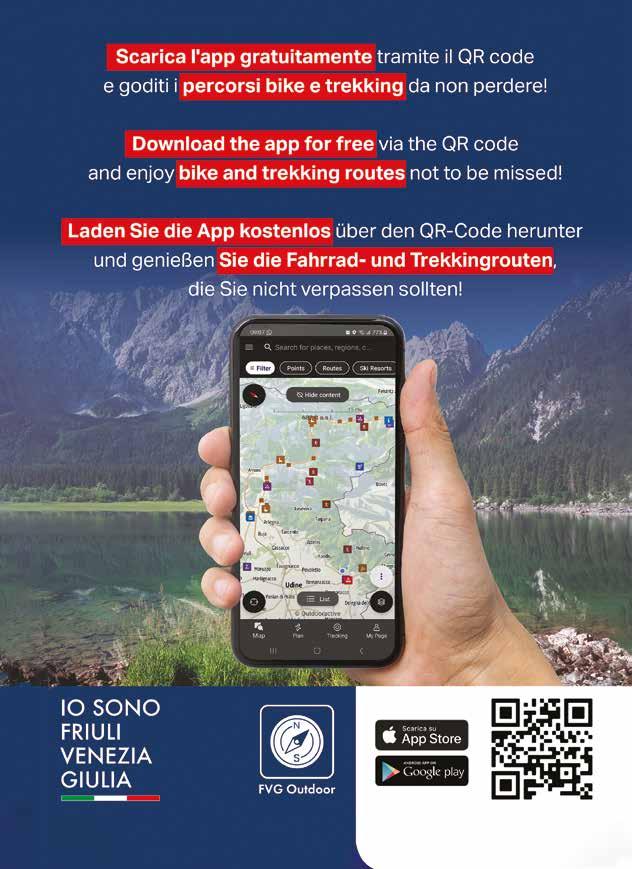
HOW TO TRAVEL TO FRIULI VENEZIA GIULIA
BY CAR
Highway:
A4 Torino/Trieste
A23 Palmanova/Udine/Tarvisio
A28 Portogruaro/Conegliano
A27/A4 Trieste/Belluno
BY PLANE Airport of Trieste www.triesteairport.it
40 km from Trieste and Udine
80 km from Pordenone
130 km from Venezia
120 km from Lubiana
BY TRAIN
www.trenitalia.it www.italotreno.it
BY BIKE www.alpe-adria-radweg.com www.adriabike.eu
BY BOAT
Along the coast and through the channels of the Lagoons of Grado and Marano Scan the QR code about Friuli Venezia Giulia
F. Gallina
M. Verin
N. Brollo
M. Milani
L. Gaudenzio
E. e S. Ciol
M. Crivellari
U. Da Pozzo
T. Balestra
L. Vitale
CREDIT INFO
PromoTurismoFVG
Strategies, Development, Operations for Tourism
Sede Marketing: via Aquileia, 46 34077 Ronchi dei Legionari (GO) info@promoturismo.fvg.it
F. Marongiu
A. Castiglioni
A. Michelazzi
L.Beretta
A. Cop
M. Valdemarin
M. Ribaudo
G. Scognamiglio Tassotto&Max
